Sustainability
ENVIRONMENT
Business Activities Paying Attention to the Environment
Environmental contribution target in VISION 2040
With the aim of contributing to the global environment, the KONDOTEC Group defines its environmental contribution target in its long-term vision VISION 2040. The target is for 2040 Scope 1 and Scope 2 greenhouse gas (GHG) emissions to be reduced by 30% from the level in the fiscal year ended March 31, 2024.
Based on our environmental policy, we will operate our business with consideration given to creating future environmental value, coexistence and harmony with the environment. We will thus aim to be a company that inspires our earth planet.
Environmental Policy
Since its foundation in 1953, KONDOTEC has created and co-existed with future environmental value and engaged in business activities paying due consideration to the environment for the realization of a sustainable society, while contributing to the creation of an affluent society through the enhancement of social infrastructure by providing products and merchandise to various industries over a half century.
- 1. We will comply with legal regulations and matters agreed on by the Company for the environment regarding business activities, products and services.
- 2. We will endeavor to reduce environmental burdens, reduce environmental pollution risks, and protect biological diversity and ecological systems by saving energy and resources, promoting recycling, reducing waste, reducing the consumption of chemical substances and engaging in green procurement.
- 3. We will continue to improve our activities by utilizing the environmental management system, setting environmental targets to achieve the Environmental Policy, conducting evaluations on environmental performance, and reviewing them regularly.
- 4. We will thoroughly inform all employees of the Environmental Policy and endeavor to conduct necessary education and enlightenment activities to engage in environment conservation activities.
Response to climate change and information disclosure based on TCFD recommendations
At KONDOTEC, in considering a path for sustainable growth, we do take into account the significant impact issues associated with climate change will have on future business activities. We are currently taking steps to recognize the impact our business activities have on the environment by management of emissions, and other measures. We view the shift to a low-carbon society as a key opportunity for us, and looking ahead we will look to pursue information disclosure based on TCFD recommendations, while implementing measures addressing climate change.
Risk management system
In collaboration with all divisions Company-wide, SDGs Promotion Department compile, assess, and identify risks and opportunities facing KONDOTEC in relation to climate change. Climate-related risks and opportunities that have been assessed and identified are reported to the Board of Directors for further supervision.
Main risks and opportunities associated with climate change
Climate-related risks and opportunities currently identified through extensive discussion with each Company division are outlined in the table below. The corresponding SDG targets are sized according to their degree of relevance.
Looking ahead,we will consider not only how to specifically address the issues that arise, but also explore the deeper aspects of them including strengthening current value creation story and tie this back to information disclosure based on TCFD recommendations.
| Item | Risks | Opportunities | Degree of impact | Future issues | Corresponding SDGs | ||
|---|---|---|---|---|---|---|---|
| Transition scenarios | Political policy and laws and regulations | Introduction of a carbon tax | ・Increased costs through the implementation of a carbon tax on CO₂ emissions from business activities (mainly the manufacturing process and logistics) | ・Business expansion related to renewable energy ・Reduction of CO₂ emissions and transportation costs by developing local suppliers to promote local production and consumption |
・Bolster procurement capabilities and production system for increased demand for products used in renewable energy facilities |
 |
|
| Tightening of regulations concerning low carbon initiatives | ・Impact on business performance by disrupted supply-demand balance due to reduced production at blast furnace companies and decreased construction demand ・Increased construction/running costs of energy-saving facilities, rising purchasing prices ・Possibility of being eliminated from the market if not compliant with regulation related to supporting low carbon ・Strengthened regulation on existing products and merchandise |
・Increased demand for low carbon facility development (wooden construction , etc.) ・Increased possibilities for product ideas and development related to eco and environment through a wide range of commercial channels ・Enhanced market value via disclosure that promotes environmental measures |
Major |
・Reduction of energy consumption and introduction of energy-saving facilities and equipment at factories ・Strengthen synergies with Group companies(promoting sales of solar power generation facilities and LED lighting, enhanced facility development capacity) ・Review changes to environmentally-friendly products and merchandise and packaging materials ・Inspect low carbon initiatives at partner factories and suppliers |
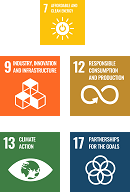 |
||
| Market | Promoting the spread of renewable energy | ・Fluctuations in purchasing prices and the cost of raw materials due to sudden and unexpected changes in energy costs |
・Increase in orders due to an increase in renewable energy facilities |
||||
| Tangible scenarios | Acute | The normalization of extraordinary climate events causing massive damage,including frequent typhoons and torrential rainfall | ・Impact on the supply of raw materials and merchandise due to damages to the supply chain |
・Increased opportunity to sell disaster preparation merchandise ・Increased demand for repair an reinforcement work on rivers and banks |
Major |
・Expand the lineup and inventory of disaster preparation products and merchandise ・Expand sales channels for products and merchandise used in civil engineering works ・Ensure multiple avenues for purchasing ・Prepare logistics simulations and plans for emergencies ・Utilization of the logistics network between operating sites |
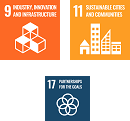 |
| Chronic | Rising in the average temperature Changes in rainfall patterns Extreme variability in weather patterns |
・Reduced productivity due to heat stroke and other factors brought on by temperature rises ・Construction delays due to rainfall and strong winds, etc. |
・Increased opportunity to sell seasonal merchandise addressing heat stroke and other issues |
・Expansion in our seasonal merchandise lineup ・Promotion of greenery on office and factory premises ・Setting of break times and drink times during periods of rising temperatures |
 |
||
Provision of Optimal Products, Merchandise and Services for Environmental Measures
Oil hunter
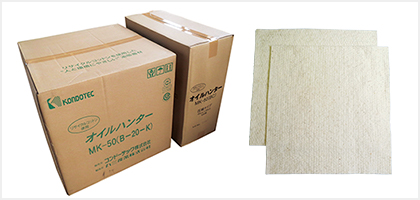
This is an eco-mark certified oil absorption mat using recycled materials. It is used for the disposing of oil at the time of marine pollution caused by oil spills and at factories which use oil.
Mash up cover
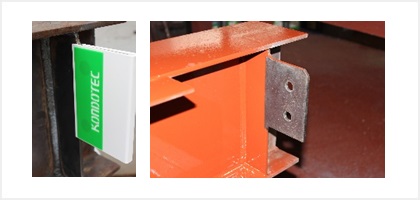
Joints in building materials intentionally create rust to fix building materials to each other through friction bonding. For this reason, masking tape or other means was used on surfaces as covering to prevent paint from coating the joints. Our development of the mash-up cover makes this covering possible without generating tape waste.
Initiatives for reducing of environmental impacts
Installation Solar power generation
Our two factories, Sanwa Denzai Co., Ltd. and TOKAI STEP CO., LTD. operate the solar power generation system in our power sales business.
In Electrical Equipment and Structural Steel Materials segments, we handle materials related to solar power generation systems and frames respectively, and focus on sales through synergies within the KONDOTEC Group.

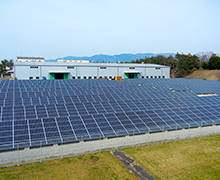
Quick delivery by four-factory structure and inventories at each operating site
KONDOTEC established factories at four locations in Japan (Hokkaido, Ibaraki, Shiga and Fukuoka), with made-to-order products such as braces and anchor bolts produced at and shipped from the nearest factory to the customer. Thanks to the four-factory structure, we reduce costs and risks associated with delivery and GHG emissions and enable to realize quick delivery. For products and merchandise which can be stored as inventories, in addition to inventories at logistics centers, we keep a certain amount at warehouses established at individual operating sites so that we can respond to abrupt demand while realizing environmental burdens and cost reduction ,and quick delivery.
Acquisition of ISO14001
We obtained ISO14001, international standards for environmental management, at all four factories, engaging in environment-friendly operations for factories.
Environmental conservation activities
As part of efforts to reduce GHG emissions, KONDOTEC has begun plans to replace Company cars with EVs, and to switch to renewable energy sources to power Company facilities. Such moves to EVs and renewable energy power sources have already gotten underway at our Head Office in 2021.
In addition, as a component of our initiatives to reduce waste, in the transport of materials from factories and logistics center to operating sites, we are operating a model by which wooden pallets, previously discarded at sites, are gathered at sites and returned to nearby factories or logistics center for reuse.
Management of emissions(Material balance)
To meet its GHG emissions reduction target, KONDOTEC has introduced the calculations of GHG emissions from KONDOTEC INC. in the fiscal year ended March 31, 2023 and has enlarged its scope to its group companies in Japan in the fiscal year ended March 31, 2024. The Company calculates GHG emissions in accordance with the GHG Protocol, an international GHG accounting standard.
GHG emissions(t-CO₂)
| Non-consolidated | Consolidated | |
|---|---|---|
| Scope1 | 1,385 | 3,693 |
| Scope2 | 2,966 | 4,601 |
(FY 2024)
* Consolidated figures do not include overseas Group companies.
* Scope 2 figures are calculated in accordance with the market-based method.
Material balance
The following illustrates the overall input-output balance and expenditures and revenues during the course from research and development to manufacturing within the business activities of KONDOTEC.
* Actual results of four factories of the Company are used.
INPUT
Raw materials |
Iron and steel | 25,540t |
|---|---|---|
| Coating Material | 93.6m3 | |
Energy |
Electricity | 5,204thousand kWh |
| Natural gas | 0m3・N or PJ | |
| LPG | 59t | |
| Diesel fuel | 2.1㎘ | |
| Kerosene | 12㎘ | |
| Heavy oil | 0.9㎘ | |
| Irrigation water | Water | 4,929m3 |
OUTPUT
| Production | Iron & steel products |
25,195t |
|---|---|---|
| Air emission | CO₂ |
2,779t |
| Industrial waste/byproduct | Recycled volume |
2,361t |
| Amount of outsourced | 172t |
|
| Drainage | Water | 4,929m3 |
(FY 2024)
<Main expenditure relating to environmental protection>
Kanto Factory:Capital investment for reducing oil leaks(5 million yen)
Disposal expenses of industrial/general waste (3 million yen)
Kyusyu Factory:Replacement of LED (15 million yen)
Paint thinner recycling equipment (1 million yen)
<Main revenues relating to environmental protection>
Revenues in business for recycling waste (e.g. steel scraps) generated from major business activities or recycling used products, etc. (104 million yen)
